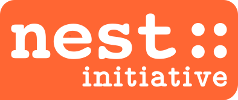
|
The 2025 NEST Conference has come to a close. A big Thank You goes to the participants for their active participation and valuable contributions that made the conference a resounding success. |
https://nest-simulator.org/conference


|
The 2025 NEST Conference has come to a close. A big Thank You goes to the participants for their active participation and valuable contributions that made the conference a resounding success. |
https://nest-simulator.org/conference
The NEST Initiative has advanced computational neuroscience since 2001 by pushing the limits of large-scale simulations of biologically realistic neuronal networks. Since 2012, the NEST Initiative is incorporated as a non-profit member-based organization promoting scientfic collaboration in computational neuroscience.
The Board and Members govern the NEST Initiative in accordance to its Statutes.
As a community of developers:
![[DOI]](https://nest-initiative.org/wp-content/papercite-data/img/page_white_link.png) Jiang HJ, Aćimović J, Manninen T, Ahokainen I, Stapmanns J, Lehtimäki M, Diesmann M, van Albada SJ., Plesser HE and Linne ML (2025) Modeling neuron-astrocyte interactions in neural networks using distributed simulation. Public Library of Science (PLoS) PLOS Computational Biology. 21:e1013503
Jiang HJ, Aćimović J, Manninen T, Ahokainen I, Stapmanns J, Lehtimäki M, Diesmann M, van Albada SJ., Plesser HE and Linne ML (2025) Modeling neuron-astrocyte interactions in neural networks using distributed simulation. Public Library of Science (PLoS) PLOS Computational Biology. 21:e1013503
![[DOI]](https://nest-initiative.org/wp-content/papercite-data/img/page_white_link.png) Linssen C., Babu PN., Eppler JM., Koll L, Rumpe B. and Morrison A. (2025) NESTML: A Generic Modeling Language and Code Generation Tool for the Simulation of Spiking Neural Networks with Advanced Plasticity Rules. Frontiers in Neuroinformatics(19)
Linssen C., Babu PN., Eppler JM., Koll L, Rumpe B. and Morrison A. (2025) NESTML: A Generic Modeling Language and Code Generation Tool for the Simulation of Spiking Neural Networks with Advanced Plasticity Rules. Frontiers in Neuroinformatics(19)
![[DOI]](https://nest-initiative.org/wp-content/papercite-data/img/page_white_link.png) Plesser HE. (2024) Commentary: Accelerating Spiking Neural Network Simulations with PymoNNto and PymoNNtorch. Frontiers Media SA Frontiers in Neuroinformatics(18)
Plesser HE. (2024) Commentary: Accelerating Spiking Neural Network Simulations with PymoNNto and PymoNNtorch. Frontiers Media SA Frontiers in Neuroinformatics(18)
![[DOI]](https://nest-initiative.org/wp-content/papercite-data/img/page_white_link.png) Golosio B., Villamar J., Tiddia G., Pastorelli E., Stapmanns J., Fanti V., Paolucci PS., Morrison A. and Senk J. (2023) Runtime Construction of Large-Scale Spiking Neuronal Network Models on GPU Devices. Mdpi Ag Applied Sciences(13):9598
Golosio B., Villamar J., Tiddia G., Pastorelli E., Stapmanns J., Fanti V., Paolucci PS., Morrison A. and Senk J. (2023) Runtime Construction of Large-Scale Spiking Neuronal Network Models on GPU Devices. Mdpi Ag Applied Sciences(13):9598
![[DOI]](https://nest-initiative.org/wp-content/papercite-data/img/page_white_link.png) Senk J., Kriener B., Djurfeldt M., Voges N., Jiang HJ., SchÜttler L., Gramelsberger G., Diesmann M., Plesser HE. and van Albada SJ. (2022) Connectivity Concepts in Neuronal Network Modeling. Public Library of Science (PLoS) PLOS Computational Biology(18):e1010086
Senk J., Kriener B., Djurfeldt M., Voges N., Jiang HJ., SchÜttler L., Gramelsberger G., Diesmann M., Plesser HE. and van Albada SJ. (2022) Connectivity Concepts in Neuronal Network Modeling. Public Library of Science (PLoS) PLOS Computational Biology(18):e1010086
![[DOI]](https://nest-initiative.org/wp-content/papercite-data/img/page_white_link.png) Tiddia G., Golosio B., Albers J., Senk J., Simula F., Pronold J., Fanti V., Pastorelli E., Paolucci PS. and van Albada SJ. (2022) Fast Simulation of a Multi-Area Spiking Network Model of Macaque Cortex on an MPI-GPU Cluster. Frontiers in Neuroinformatics(16):883333
Tiddia G., Golosio B., Albers J., Senk J., Simula F., Pronold J., Fanti V., Pastorelli E., Paolucci PS. and van Albada SJ. (2022) Fast Simulation of a Multi-Area Spiking Network Model of Macaque Cortex on an MPI-GPU Cluster. Frontiers in Neuroinformatics(16):883333
You will find a detailed bibliography of publications on simulation technology and NEST-based computational neuroscience studies on our Publications page.
There are many ways to be a part of the NEST Community.
Welcome aboard!